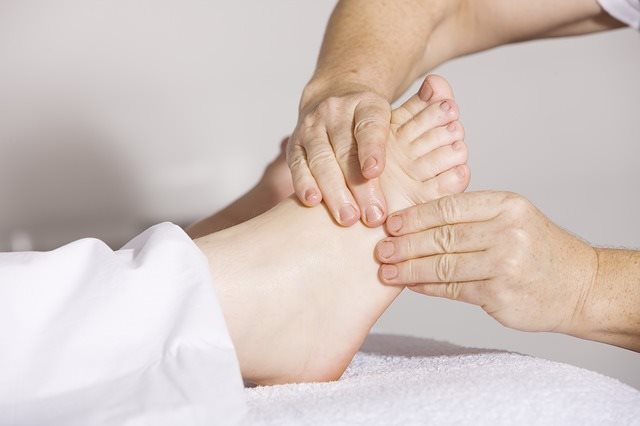Bowen Therapy for Plantar Fasciitis

Bowen Therapy: Permanent Treatment for Sciatic Pain
May 20, 2017
HOW IS TESTOSTERONE THERAPY BEING DONE?
August 3, 2017Plantar Fasciitis is a horribly painful foot condition, that is only going to grow worse with time if you do not take it seriously and actively work on. The condition can be caused by multiple causes, each of which will have to be addressed if you are to stand any chance of regaining your normal life. The quality of a person’s living standard is going to decrease the more painful the plantar fasciitis condition is. When you have PF, it will feel like you are standing in a bucket of shart metal fragments when you get out of bed in the morning.
Plantar fasciitis is caused by an inflamed plantar fascia. The plantar fascia is the ligament that runs from your heel to your toes, at the bottom of your feet. It’s the foot’s largest ligament and you couldn’t do without it. When it becomes inflamed, it thickens and stiffens. This makes it very painful to walk on. You will feel the pain caused by this condition in your heels. They will become so painful, that you will find living your day to day life near impossible.
What Causes Plantar Fasciitis?
The condition is heriditary, meaning that if your parents or grandparents have had to deal with it, odds are greater than average that you, at one point, will also have to deal with it. If you are overweight, the risk factor increases even more. Something that will also help in developing a case of PF, is having to stand up straight for long periods of time. You will often see store clerks, police offers, security personnel, or people in similar types of professions, develop plantar fasciitis. You can also get it from intensive activities such as hiking
There are things you can do to treat your plantar fasciitis. The sooner you get started on it, the better off you’ll be. The condition is going to become worse and more painful as time goes on, when you do not do anything about it. You must learn to recognize this condition if you want to be in time to treat it well. The goals of a plantar fasciitis treatment are as follows:
- To improve flexibility and strength and to correct problems with your feet, such as too much pronation. This will cause you to not stress your ligaments so much.
- To relieve the inflammation that is casuing the pain in your heel.
- To allow the plantar fascia ligament’s small tears to heal.
Should you take your treatment seriously, and we here at Bowen highly recommend that you do, then odds are that you will completely recover within the span of a year. Out of a 100 people who are diagnosed with this affliction, around 95 are capable of curing their PF without the need for surgical intervention. Only the remaining 5 will need surgery. Since surgery is something to be avoided at all costs, it’s best if you give it all you’ve got on your treatment.
How To Treat Plantar Fasciitis?
 There are many things you can do in order to help yourself conquer PF. Below you will find some methods that you can use in order to get yourself back on your feet painlessly. Not all these methods have been scientifically proven, but most of them work really well for most people.
There are many things you can do in order to help yourself conquer PF. Below you will find some methods that you can use in order to get yourself back on your feet painlessly. Not all these methods have been scientifically proven, but most of them work really well for most people.
- Improve your feet’s support by wearing good shoes that give you good arch support and that have great shock absorption. In most cases, that means you’ll have to go with athletic shoes. Just so long as the shoes have a well cushioned sole.
- Get good shoe inserts, or heel cups at the very least, in order to help cushion your heel. These sorts of inserts are available at many shoe stores or even drugstores. It’s always recommended that you put these in both shoes, even when you’ve got only one painful heel that needs them.
- Put some ice on your heel in order to reduce the inflammation. There are over the counter pain killers that you can use in order to further decrease inflammation, such as Naproxen or Ubiprofen. These are so called nonsteroidal anti inflammatory drugs that work well, precisely because they suppress inflammation. You can get these in either a pill or a cream form.
- Give your feet lots of rest. Reduce or stop activities that have caused your heel pain in the first place. Do not run, walk or jump on hard surfaces, such as concrete.
- Make sure to put on your shoes as quickly as you can after getting out of bed. Walking around on bare feet is not going to help you overcome your PF. As a matter of fact, it will make your heel pain even worse if you continue to do this for a long time.
- Do some simple stretching exercises, such as towel stretches, calf stretches or toe stretches. It’s most effective if you do these exercises multiple times per day. Since your heel pain will be at its worst early in the morning, it helps to start out your morning with these stretching exercises.
- Do not use only heat to treat your feet, such as heating packs or a heating pad. For some reason, heat will cause the situation to become worse for some people. When making use of a contrast bath, which alternates between hot and cold water, make sure to end the bath on cold water.
- Lose weight in order to decrease the stress you are putting on your feet, simply by being heavy. Whichever body weight you’ve got, it will constantly stress your feet for every second of the day that you are standing up. If standing up is part of your daily job, then losing weight is one of the most effective things you can do in order to cure your plantar fasciitis and to prevent future occurrences of it.
- Use night splints to keep your feet in a stretched position during the night. This will prevent pain in the morning. With PF, heel pain in the morning is caused by your plantar fascia contracting and spending hours in that position. Getting up stretches your stiffened plantar fascias, immediately invoking the dreaded morning pain. Prevent this by keeping them stretched with a night splint.
We at Bowen therapists hope you will be able to use the above advice to help yourself cure your plantar fasciitis. If you feel you need help, please contact us.


